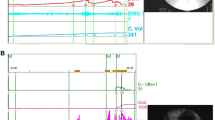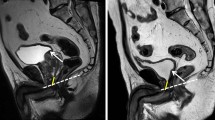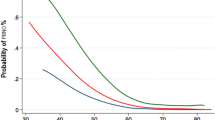Abstract
In any type of lower urinary tract dysfunction it is mandatory to obtain as much information as possible on the function of the urinary tract. By definition of the International Continence Society, any investigation that produces such information is part of urodynamics. Thus, voiding and defecation history, physical examination, voiding frequency charts and defecation diaries are all essential parts of urodynamics. Repeated free uroflowmetry is considered an essential routine investigation by the International Children's Continence Society. Static and dynamic ultrasonography of the lower urinary tract and the pelvic floor can give important information on lower urinary tract anatomy and function, in a noninvasive manner. Invasive urodynamic studies such as voiding cystourethrography and cystometry are reserved for patients for whom the outcome of such studies is expected to change the therapeutic regime. Invasive urodynamic tests are performed primarily for one of two reasons. First, to confirm an expected diagnosis in new patients. Second, to ensure that the storage pressures in the bladder remain safe for normal functioning of the kidneys in children with chronic disease.
Key Points
-
Any information on the function of the urinary tract is part of urodynamics; a meticulous micturition and defecation history with voiding and defecation diary are invaluable in pediatric patients
-
Invasive urodynamic studies are done to obtain information that directs or changes the treatment of the individual child
-
When diagnosis is done properly, straightforward therapy can be given and the psychological trauma associated with failure to respond to ill-defined treatment strategies can be avoided
-
In patients with chronic lower urinary tract dysfunction of neurogenic origin or after severe obstructive uropathy, invasive urodynamic studies ensure that bladder pressures remain safe, to protect kidney function
-
In a patient with lower urinary tract symptoms, any sign of structural anomalies must be investigated to exclude neurogenic bladder dysfunction
This is a preview of subscription content, access via your institution
Access options
Subscribe to this journal
Receive 12 print issues and online access
$209.00 per year
only $17.42 per issue
Buy this article
- Purchase on Springer Link
- Instant access to full article PDF
Prices may be subject to local taxes which are calculated during checkout







Similar content being viewed by others
References
Homma, Y. et al. in Incontinence: 2nd International Consultation on Incontinence, 2001 2nd edn, Ch. 7 (eds Abrams, P. et al.) 317–372 (Health Publications, Plymouth, 2002).
Nevéus, T. et al. The standardization of terminology of lower urinary tract function in children and adolescents: report from the Standardisation Committee of the International Children's Continence Society. J. Urol. 176, 314–324 (2006).
Tekgul, S. et al. in Incontinence 4th edn (eds Abrams, P. et al.) (Health Publications, Plymouth, 2009).
Rasquin, A. et al. Childhood functional gastrointestinal disorders: child/adolescent. Gastroenterology 130, 1527–1537 (2006).
Hyman, P. E. et al. Childhood functional gastrointestinal disorders: neonate/toddler. Gastroenterology 130, 1519–1526 (2006).
Mosiello, G. et al. How to investigate neurovesical dysfunction in children with anorectal malformations. J. Urol. 170, 1610–1613 (2003).
De Gennaro, M. et al. The incidence of occult spinal dysraphism and the onset of neurovesical dysfunction in children with anorectal anomalies. Eur. J. Pediatr. Surg. 4 (Suppl. 1), 12–14 (1994).
De Gennaro, M., Capitanucci, M. L., Mosiello, G., Caione, P. & Silveri, M. The changing urodynamic pattern from infancy to adolescence in boys with posterior urethral valves. BJU Int. 85, 1104–1108 (2000).
De Gennaro, M. et al. Detrusor hypocontractility in children with posterior urethral valves arises before puberty. Br. J. Urol. 81 (Suppl. 3), 81–85 (1998).
Szabo, L., Lombay, B., Borbas, E. & Bajusz, I. Videourodynamics in the diagnosis of urinary tract abnormalities in a single center. Pediatr. Nephrol. 19, 326–331 (2004).
Hosker, G. et al. in Incontinence 4th edn (eds Abrams, P. et al.) 585–673 (Health Publications, Plymouth, 2009).
Ural, Z., Ulman, I. & Avanoglu, A. Bladder dynamics and vesicoureteral reflux: factors associated with idiopathic lower urinary tract dysfunction in children. J. Urol. 179, 1564–1567 (2008).
Heron, J., Joinson, C., Croudace, T. & von Gontard, A. Trajectories of daytime wetting and soiling in a United Kingdom 4 to 9-year-old population birth cohort study. J. Urol. 179, 1970–1975 (2008).
Söderstrom, U., Hoelcke, M., Alenius, L., Söderling, A. C. & Hjern, A. Urinary and fecal incontinence: a population-based study. Acta Paediatr. 93, 386–389 (2004).
Dogan, H. S. et al. Non-invasive evaluation of voiding function in asymptomatic primary school children. Pediatr. Nephrol. 23, 1115–1122 (2008).
Yeung, C. K., Sreedhar, B., Leung, Y. F. & Sit, K. Y. Correlation between ultrasonographic bladder measurements and urodynamic findings in children with recurrent urinary tract infection. BJU Int. 99, 651–655 (2007).
Yeung, C. K., Sreedhar, B., Leung, V. T. & Metreweli, C. Ultrasound bladder measurements in patients with primary nocturnal enuresis: a urodynamic and treatment outcome correlation. J. Urol. 171, 2589–2594 (2004).
Klijn, A. J., Asselman, M., Vijverberg, M. A., Dik, P. & de Jong, T. P. The diameter of the rectum on ultrasonography as a diagnostic tool for constipation in children with dysfunctional voiding. J. Urol. 172, 1986–1988 (2004).
Joensson, I. M., Siggaard, C., Rittig, S., Hagstroem, S. & Djurhuus, J. C. Transabdominal ultrasound of rectum as a diagnostic tool in childhood constipation. J. Urol. 179, 1997–2002 (2008).
de Jong, T. P. et al. Effect of biofeedback training on paradoxical pelvic floor movement in children with dysfunctional voiding. Urology 70, 790–793 (2007).
de Jong, T. P., Klijn, A. J., Vijverberg, M. A. & de Kort, L. M. Ultrasound imaging of sacral reflexes. Urology 68, 652–654 (2006).
de Kort, L. M., Verhulst, J. A., Engelbert, R. H., Uiterwaal, C. S. & de Jong, T. P. Lower urinary tract dysfunction in children with generalized hypermobility of joints. J. Urol. 170, 1971–1974 (2003).
Abrams, P. et al. The standardisation of terminology of lower urinary tract function: report from the standardisation sub-committee of the International Continence Society. Neurourol. Urodyn. 21, 167–178 (2002).
Schober, J. M., Dulabon, L. M. & Woodhouse, C. R. Outcome of valve ablation in late-presenting posterior urethral valves. BJU Int. 94, 616–619 (2004).
de Jong, T. P. et al. Posterior urethral valves: search for a diagnostic reference standard. Urology 72, 1022–1025 (2008).
de Kort, L. M. et al. Reliability of voiding cystourethrography to detect urethral obstruction in boys. Urology 63, 967–971 (2004).
de Kort, L. M., Klijn, A. J., Dik, P., Uiterwaal, C. S. & de Jong, T. P. Oxybutynin for diagnosis of infravesical obstruction in boys with urinary incontinence. Urology 62, 127–130 (2003).
Hoebeke, P., Van Laecke, E., Raes, A., van Gool, J. D. & Vande Walle, J. Anomalies of the external urethral meatus in girls with non-neurogenic bladder sphincter dysfunction. BJU Int. 83, 294–298 (1999).
Klijn, A. J. et al. Home uroflowmetry biofeedback in behavioral training for dysfunctional voiding in school-age children: a randomized controlled study. J. Urol. 175, 2263–2268 (2006).
Hinman, F. & Baumann, F. W. Vesical and ureteral damage from voiding dysfunction in boys without neurologic or obstructive disease. J. Urol. 109, 727–732 (1973).
Sherman, N. D., Stock, J. A. & Hanna, M. K. Bladder dysfunction after bilateral ectopic ureterocele repair. J. Urol. 170, 1975–1977 (2003).
Abrahamsson, K., Hansson, E., Sillen, U., Hermansson, G. & Hjalmas, K. Bladder dysfunction: an integral part of the ectopic ureterocele complex. J. Urol. 160, 1468–1470 (1998).
Beganovic, A., Klijn, A. J., Dik, P. & de Jong, T. P. Ectopic ureterocele: long-term results of open surgical therapy in 54 patients. J. Urol. 178, 251–254 (2007).
Bauer, S. B. et al. Predictive value of urodynamic evaluation in newborns with myelodysplasia. JAMA 252, 650–652 (1984).
Dik, P., Klijn, A. J., van Gool, J. D., de Jong–de Vos van Steenwijk, C. C. & de Jong, T. P. Early start to therapy preserves kidney function in spina bifida patients. Eur. Urol. 49, 908–913 (2006).
de Jong, T. P., Chrzan, R., Klijn, A. J. & Dik, P. Treatment of the neurogenic bladder in spina bifida. Pediatr. Nephrol. 23, 889–896 (2008).
Ozel, S. K., Dokumcu, Z., Akyildiz, C., Avanoglu, A. & Ulman, I. Factors affecting renal scar development in children with spina bifida. Urol. Int. 79, 133–136 (2007).
De Gennaro, M., Capitanucci, M. L., Silveri, M., Morini, F. A. & Mosiello, G. Detrusor hypocontractility evolution in boys with posterior urethral valves detected by pressure flow analysis. J. Urol. 165, 2248–2252 (2001).
Koff, S. A., Mutabagani, K. H. & Jayanthi, V. R. The valve bladder syndrome: pathophysiology and treatment with nocturnal bladder emptying. J. Urol. 167, 291–297 (2002).
de Kort, L. M., Klijn, A. J., Uiterwaal, C. S. & de Jong, T. P. Ureteral reimplantation in infants and children: effect on bladder function. J. Urol. 167, 285–287 (2002).
Hoebeke, P., Van, L. E., Van, C. C., Raes, A. & Van De Walle, J. One thousand video-urodynamic studies in children with non-neurogenic bladder sphincter dysfunction. BJU Int. 87, 575–580 (2001).
Schafer, W. et al. Good urodynamic practices: uroflowmetry, filling cystometry, and pressure-flow studies. Neurourol. Urodyn. 21, 261–274 (2002).
Luijt, D. S., Schirm, J., Savelkoul, P. H. & Hoekstra, A. Risk of infection by reprocessed and resterilized virus-contaminated catheters: an in vitro study. Eur. Heart J. 22, 378–384 (2001).
Ishino, Y., Ido, K. & Sugano, K. Contamination with hepatitis B virus DNA in gastrointestinal endoscope channels: risk of infection on reuse after on-site cleaning. Endoscopy 37, 548–551 (2005).
Sozubir, S., Celik, A., Emir, N., Avanoglu, A. & Ulman, I. Consistency of urodynamic parameters in children with detrusor instability: how many times should the bladder be filled? Urol. Int. 75, 129–132 (2005).
Koff, S. A. Estimating bladder capacity in children. Urology 21, 248 (1983).
Berger, R. M., Maizels, M., Moran, G. C., Conway, J. J. & Firlit, C. F. Bladder capacity (ounces) equals age (years) plus 2 predicts normal bladder capacity and aids in diagnosis of abnormal voiding patterns. J. Urol. 129, 347–349 (1983).
Wahl, E. F. & Churchill, B. M. Detrusor pressure rise in a normal bladder. BJU Int. 94, 901–902 (2004).
Wahl, E. F., Lerman, S. E., Lahdes-Vasama, T. T. & Churchill, B. M. Measurement of bladder compliance can be standardized by a dimensionless number: clinical perspective. BJU Int. 94, 898–900 (2004).
Ghobish, A. G. Storage detrusor pressure in bilateral hydroureteronephrosis. Eur. Urol. 39, 571–574 (2001).
Vereecken, R. L. & Proesmans, W. Urethral instability as an important element of dysfunctional voiding. J. Urol. 163, 585–588 (2000).
McCormack, M., Pike, J. & Kiruluta, G. Leak point of incontinence: a measure of the interaction between outlet resistance and bladder capacity. J. Urol. 150, 162–164 (1993).
Vanderbrink, B. A., Gitlin, J. & Palmer, L. S. Uroflowmetry parameters before and after meatoplasty for primary symptomatic meatal stenosis in children. J. Urol. 179, 2403–2406 (2008).
Farhane, S. et al. Uroflowmetry in children: prospective study of normal parameters [French]. Prog. Urol. 16, 598–601 (2006).
Szabo, L. & Fegyverneki, S. Maximum and average urine flow rates in normal children—the Miskolc nomograms. Br. J. Urol. 76, 16–20 (1995).
Wese, F. X. et al. Body surface related flow rate nomograms in a normal pediatric population. Acta Urol. Belg. 57, 467–474 (1989).
Schmidt, F., Jorgensen, T. M. & Djurhuus, J. C. Twenty-four-hour ambulatory urodynamics in healthy young men. Scand. J. Urol. Nephrol. 215 (Suppl.), 75–83 (2004).
Schmidt, F., Shin, P., Jorgensen, T. M., Djurhuus, J. C. & Constantinou, C. E. Urodynamic patterns of normal male micturition: influence of water consumption on urine production and detrusor function. J. Urol. 168, 1458–1463 (2002).
Defreitas, G. A., Zimmern, P. E., Lemack, G. E. & Shariat, S. F. Refining diagnosis of anatomic female bladder outlet obstruction: comparison of pressure-flow study parameters in clinically obstructed women with those of normal controls. Urology 64, 675–679 (2004).
Sillén, U. Bladder function in infants. Scand. J. Urol. Nephrol. 215 (Suppl.), 69–74 (2004).
Yeung, C. K. et al. Some new insights into bladder function in infancy. Br. J. Urol. 76, 235–240 (1995).
Halachmi, S. The molecular pathways behind bladder stretch injury. J. Pediatr. Urol. 5, 13–16 (2009).
Acknowledgements
Charles P. Vega, University of California, Irvine, CA, is the author of and is solely responsible for the content of the learning objectives, questions and answers of the MedscapeCME-accredited continuing medical education activity associated with this article.
Author information
Authors and Affiliations
Corresponding author
Ethics declarations
Competing interests
The authors declare no competing financial interests.
Rights and permissions
About this article
Cite this article
de Jong, T., Klijn, A. Urodynamic studies in pediatric urology. Nat Rev Urol 6, 585–594 (2009). https://doi.org/10.1038/nrurol.2009.200
Issue Date:
DOI: https://doi.org/10.1038/nrurol.2009.200



